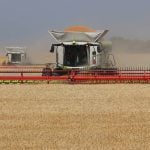How have global temperatures fared so far this year? According to the Copernicus Climate Change Service, 2024 is more than likely to be the warmest year on record. October was the second warmest on record and the 15th month of the last 16 months where temperatures were above the 1.5 C threshold.
Projections show the average global temperature for 2024 will be around 1.55 C above the pre-industrial average, compared to 1.48 C in 2023. What will 2025 bring?
Let’s see how November’s weather across the Prairies compares to these trends. A bit of a caveat: due to my print deadline, I had to use forecasted temperatures for the last few days of the month to calculate the mean monthly temperatures.
Read Also

What is perfect Christmas weather?
What is ‘perfect’ Christmas weather on the Prairies? Here’s where you should head this holiday, according to historical weather data.


I can almost use the exact same wording I used for October to describe November. Both the warmest region and the region with the highest above average temperatures was the eastern Prairies, with the exception of Calgary. Winnipeg earned top spot for both the warmest mean temperature and warmest difference from average. Alberta was a bit below average for the month.
Here are the precipitation values for November.


Above-average precipitation came to the eastern Prairies. As with temperatures, precipitation amounts dropped off toward the west. The Peace River region was the only area with below-average amounts. In Manitoba, it is unusual to see a warm and wet November, as most wet Novembers are cold with heavy snowfalls.
Overall, it was a warmer-than-average month over the eastern half of the Prairies with near- to slightly-below-average temperatures over the western half. Precipitation followed a similar pattern, with eastern regions seeing above-average amounts and western regions, with the exception of Calgary, getting near- to below-average amounts.
Looking at forecasts for the month, the winner is a toss up between the Old Farmers Almanac and the ECMWF model. The Old Farmer’s Almanac called for a warmer and wetter than average November, and the ECMWF or European weather model called for near-average temperatures and Manitoba with above-average temperatures.
Both of them called for above-average precipitation across all three Prairie provinces, which was basically correct, but the extra detail about the eastern Prairies having the best chance of above-average temperatures gives the win to the ECMWF model.
Now to December forecasts or predictions. In my opinion, the word forecast should be used for anything less than 14 days, and anything over 14 days should be called a prediction.
We will start with the almanacs. The Old Farmer’s Almanac forecast is for a warmer and slightly wetter than average December, and in my books, this would not be that bad. The Canadian Farmers Almanac calls for plenty of snow and near-average temperatures, and I would not be disappointed if this forecast proves true. After all, if it is cold out, we might as well be able to play in the snow.
NOAA’s 30-day prediction, extrapolated northward, calls for below-average temperatures across the Prairies, with the coldest readings over the western half. Its precipitation prediction is near-average amounts over eastern regions and above-average amounts in the west.
My favourite, the CFS model, predicts a warmer-than-average month with near-average precipitation over southern regions and above-average amounts over more northern locations.
The Canadian CanSIPS model calls for slightly below-average temperatures and near-average precipitation. The last weather model, the ECMWF or European model, predicts near- to above-average temperatures over the eastern Prairies and near-average temperatures in the west. Its precipitation prediction is interesting, because it calls for above- to well above-average amounts over Alberta, transitioning to near-average as you move eastward into Manitoba.
Last is my prediction. I take into account my understanding of weather patterns and climatology and then add my knowledge of how the different weather models work – something often called the art of weather prediction. My problem is, I have never been a great artist.
My weather gut says we will see near- to slightly above-average temperatures in December across the Prairies, with near-average amounts of snow.
















